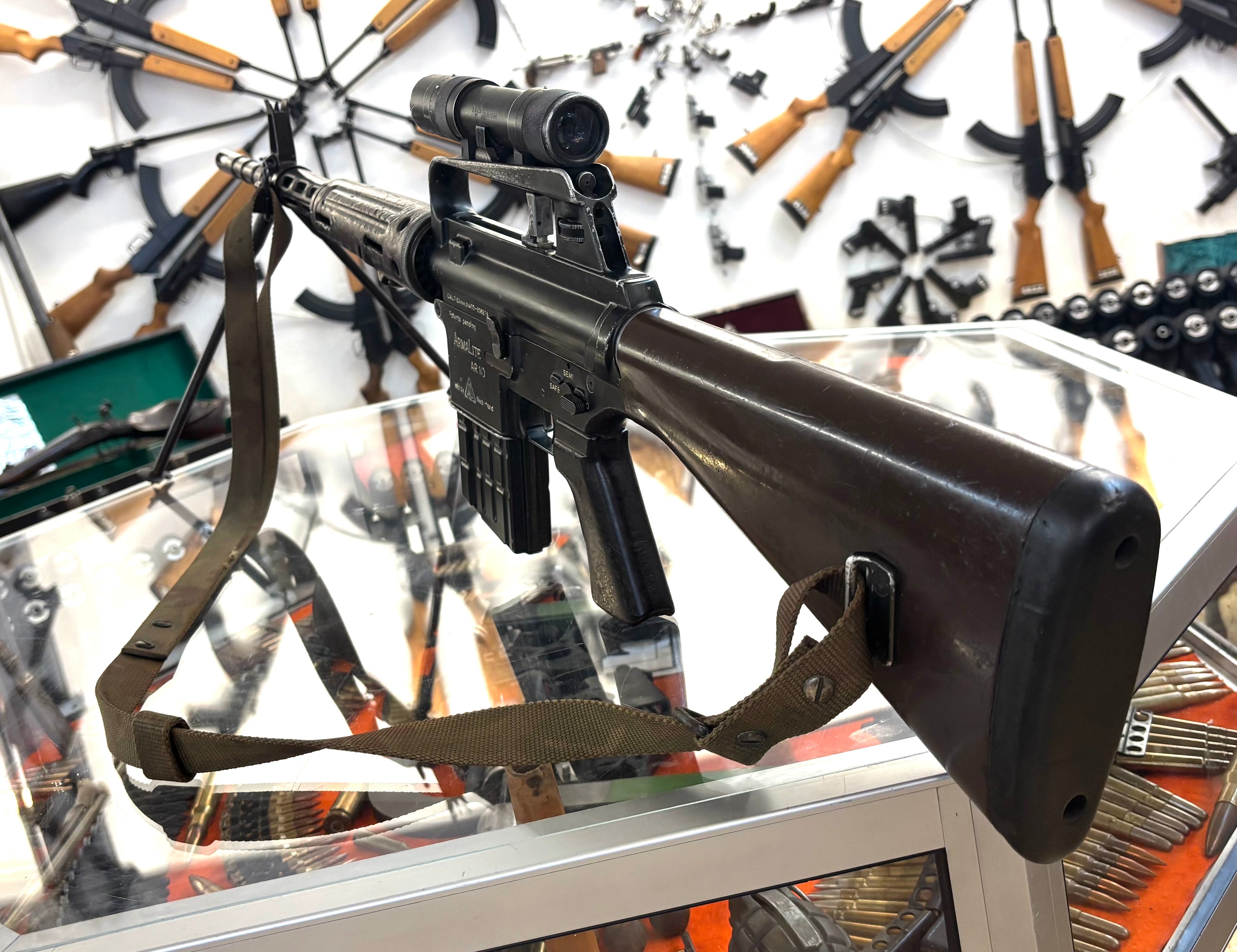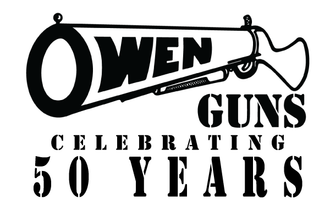
Armalite AR-10 Battle Rifle
This week for Firearm Friday we are bringing you the ArmaLite AR-10 battle rifle and they are the first AR-10 platform produced in the world. It is on display in our museum and is pictured with a Smith & Wesson M&P10 which is a much later version/variant of a AR-10 framed battle rifle.

It is a 7.62×51mm NATO battle rifle designed by Eugene Stoner in the late 1950s and manufactured by ArmaLite. and first introduced in 1956, the AR-10 used an innovative combination of a straight-line barrel/stock design with a composite, a new patent-filed gas-operated bolt and carrier system and forged alloy parts resulting in a small arm significantly easier to control in automatic fire and over 0.45 kg lighter than other infantry rifles of the day. The original AR-10 was built in relatively small numbers, with fewer than 10,000 rifles assembled. The ArmaLite AR-10 would become the blueprint for a wide range of firearms.

ArmaLite began as a small engineering company founded by George Sullivan, 1954, the company was incorporated as the ArmaLite Corporation, becoming a subdivision of Fairchild Engine and Airplane Corporation. With its limited capital and tiny machine shop, ArmaLite was never intended to be an arms manufacturer. The company focused on producing small arms concepts and designs to be sold or licensed to other manufacturers. Sullivan began work on a prototype for a lightweight survival rifle for use by downed aircrew.

While testing the prototype of the ArmaLite AR-5 survival rifle design at a local shooting range, Sullivan met Eugene Stoner, a small arms inventor, whom Sullivan hired to be ArmaLite's chief design engineer. The first prototypes of the 7.62 mm AR-10 emerged between 1955 and early 1956. At the time, the United States Army was in the midst of testing several rifles to replace the obsolete M1 Garand.

ArmaLite's AR-10 entered the competition late, hurriedly submitting two hand-built "production" AR-10 rifles based on the fourth prototype in the fall of 1956 to the United States Army's Springfield Armory for testing. For a 7.62mm NATO rifle, the AR-10 prototype was incredibly lightweight at only 6.85 lb empty. Initial comments by Springfield Armory test staff were favorable, and some testers commented that the AR-10 was the best lightweight automatic rifle tested by the Armory.

The rifle's aluminum/steel composite barrel burst in a torture test conducted by Springfield Armory in early 1957. ArmaLite quickly replaced it with a conventional steel barrel, but the damage had been done. While ArmaLite objected, it was clear that the AR-10, a rifle still in the prototype stage, was at a disadvantage compared to competing designs that had been in development for a longer period of time, and by 1957, U.S. Army infantry forces urgently required a modern, magazine-fed infantry rifle to replace the M1. In the end, the Army chose the conventional T44, which entered production as the M14 rifle in 1957.

AR-10 production was limited, though Guatemala, Burma, Italy, Cuba, Sudan and Portugal all purchased AR-10 rifles for limited issue to their military forces. Sudanese AR-10s were employed in frequent clashes with guerrilla forces and conflicts with neighboring countries, and a few captured rifles eventually turned up in unofficial service with various African and colonial armies, police, and guerrilla forces. However, rapidly worsening relations with the United States eliminated any chance of future AR-10 sales to Cuba, and Castro transferred the ex-Batista AR-10s to a group of Communist revolutionaries from the Dominican Republic. In June 1959, the rebels, led by Cuban officers, invaded the Dominican Republic. The invaders were defeated by the Dominican Army, and AR-10 rifles from the Batista shipment were found on the bodies of guerrillas.

The final Artillerie Inrichtingen design is known as the Portuguese model AR-10. This final version incorporated all that had been learned to date about the AR-10, including infantry service rifle and field test reports. In addition to a heavier barrel with chrome-lined chamber, optional bipod, and the removable plastic/metal handguards of the Transitional model, the Portuguese variant had wider bolt lugs, a stronger extractor, a new simplified three-position gas regulator, and a cocking handle featuring a forward bolt assist. It is believed that approximately 4,000-5,000 Portuguese variants were produced.

In later years, some ex-military Sudanese and Portuguese model AR-10s were sold to civilian markets in the U.S., Canada, Australia, and New Zealand. Nearly all of the rifles imported to the latter three countries had their full-automatic fire selector disabled. Subsequently, as many as 2,500 Australian AR-10 rifles may have been confiscated and destroyed as a result of more restrictive firearms legislation passed in 1997.

In 1959, ArmaLite sold its rights to the AR-10 and AR-15 to Colt Firearms due to financial difficulties, and limitations in terms of manpower and production capacity. After modifications (most notably, the charging handle was relocated from under the carrying handle like AR-10 to the rear of the receiver), the new redesigned rifle was subsequently adopted by the U.S. military as the M16 rifle. Colt continued to use the AR-15 trademark for its line of semi-automatic rifles marketed to civilian and law-enforcement customers, known as Colt AR-15.

The AR-10 is a lightweight, air-cooled, magazine-fed, gas-operated rifle that uses a piston within the bolt carrier with a rotary bolt locking mechanism. The rifle has a conventional layout; it features an in-line stock, an aluminum alloy receiver and a fiberglass reinforced pistol grip, handguard, and buttstock. As part of the weight-saving design philosophy, in U.S. patent 2,951,424 the designer points out that.

By having the bolt carrier act as a movable cylinder and the bolt act as a stationary piston, the need for a conventional gas cylinder, piston and actuating rod assembly is eliminated. The gas system, bolt carrier, and bolt-locking design were novel for the time. Most gas-operated rifles divert combustion gases from a port in the barrel to a piston and cylinder arrangement adjacent to the port. In Stoner's design, the gas travels from a port near the middle of the barrel through a steel tube back into the receiver. The gas enters a chamber inside the bolt carrier formed between the rear of the bolt and the inside of the bolt carrier. The bolt within the bolt carrier is fitted with piston rings to contain the gas. Once the bolt carrier moves to the rear a small distance, excess gas is vented through holes in its side. This use of the bolt and bolt carrier for the separate actions of a piston and gas cylinder simplified construction and saved weight. The Stoner bolt and carrier piston system is however ammunition specific, since it does not have an adjustable gas port or valve to adjust the weapon to various propellant and projectile or barrel length specific pressure behavior. Movement of the bolt carrier was in-line with the bore, greatly improving inherent accuracy, as well as keeping the rifle on target as the gun fired.

While ArmaLite Inc. holds a US trademark on the name "AR-10", other rifle manufacturers currently produce 7.62×51mm NATO auto-loading rifles that are based generally on the AR-10 design. These rifles differ from both the current and original ArmaLite AR10 in a few minor dimensions that make the ArmaLite AR10B not as modular as the rest of the AR-based firearms. Some of these companies offer selective-fire versions and versions in different calibers.

DPMS LR-308
Knights Armament Corporation SR-25
Knights Armament Corporation M110 Semi-Automatic Sniper System
Rock River Arms LAR-8
Lewis Machine and Tool LM308MWS/L129A1
Bushmaster MOE 16 .308
Daniel Defense DD5
Palmetto State Armory PA-10
Sako M23
SIG Sauer 716i
Smith & Wesson M&P10
Colt Canada C20 DMR
Aero Precision M5 (AR308)














